|

On eBay Now...
1886 BUFFALO ARCHITECTURE ARCHITECT RICHARD WHITE CAST IRON VICTORIAN ERA DESIGN For Sale

When you click on links to various merchants on this site and make a purchase, this can result in this site earning a commission. Affiliate programs and affiliations include, but are not limited to, the eBay Partner Network.

1886 BUFFALO ARCHITECTURE ARCHITECT RICHARD WHITE CAST IRON VICTORIAN ERA DESIGN:
$52.50
Great Antique 1886 PRINT AD for BUFFALO, NY ARCHITECT RICHARD A. WAITE Very good print ad - see photos for condition. Print Ad measures approx. 5\" x 5-1/2\", printing on verso. Authentic original document - not a reprint or reproduction. From the 1886 City of Buffalo Directory Richard Alfred Waite was one of Buffalo’s most prominent architects of the mid to late nineteenth-century. Waite was responsible for many of Buffalo’s most recognizable buildings of the late 1900s, and also achieved international fame as an architect of several major projects across Canada. Today few of Waite’s masterpieces remain standing in Buffalo, and in fact all of his most prominent public buildings have been lost. Many of his elegant cast iron designs succumbed to later urban development in the twentieth-century, yet the appreciation of Waite as one of the masters of architectural design in the Great Lakes region is growing. The Glenny Building at 257 Main Street remains as the sole heir of Waite’s mastery of cast iron architecture, and although he was dubbed a “dreamer in iron” by his own son, Waite’s numerous cast iron buildings have now been lost. Several of Waite’s residential works remain, protected by the Allentown Historic District in Buffalo, and the Ontario Parliament Buildings also remain in Toronto. Buffalo is fortunate to retain one of the few examples of Waite’s commercial architecture in the Werner Photography Building at 101-103 Genesee Street, which although a relatively modest yet unique example of the architect’s work, remains largely intact and serves as a reminder of one of Buffalo’s greatest architects. Waite’s earliest known project was the Public School 32 on Cedar Street designed in the late 1870s. In 1872 Waite won a design competition for the new Trinity Episcopal Church at Delaware and Johnson Park, beating out several prominent architects including architectural superstar, H.H. Richardson. Although this building was never constructed, this competition did bring new attention to Waite’s work. Waite’s reputation was growing quickly in the 1870s, and Waite was awarded the contract to design the German Insurance Building (1874-75, demolished 1957), the largest office building in Buffalo at the time of its design. Showcasing Waite’s training with Kellum, the German Insurance Building, located on a prominent site overlooking Lafayette Square, was a frothy, multi-layered six-story building which introduced the fashionable Second Empire Style to Buffalo. Constructed of brick, what could have been a solid mass of masonry building was lightened with the textural play of cast iron columns, pilasters and arches across the building’s two primary street facades. A stylish mansard roof with elaborate dormer windows and delicate cast iron cresting, created a signature silhouette for the building on the Buffalo skyline. This statement piece of modern architecture in the 1870s cemented the young Waite’s identity as one of Buffalo’s most popular architects. Waite designed a wide variety of buildings following the German Insurance Building. Although the massive Pierce’s Palace Hotel (1876-78), another masterpiece of Second Empire cast iron design, was destroyed by fire in 1881 shortly after its construction, Waite had many other buildings throughout the city. The five-story W.H. Glenny & Sons Building (1877, contributing building to NPS certified local Joseph Ellicott Historic District, 1979) located at 257 Main Street is the last remaining cast iron fronted building in Buffalo. Waite, with the help of his brother-in-law John A. Holloway, constructed three small mansard roof cottages on Pennsylvania Street (extant in modified condition), one of which served as Waite’s own home for over twenty-five years. Waite also designed several stately Second Empire mansions including the Farrar House at 506 Delaware Avenue (1877, contributing to Allentown Historic District, NR 1980) and the Frank Hamlin House at 420 Franklin Street (1877, contributing to Allentown Historic District). Waite also designed one of the city’s rare examples of the Stick Style in the George Williams House at 249 North Street (1877, contributing to Allentown Historic District). Waite returned to his love of brick construction in the Phillip Becker Mansion at 534 Delaware Avenue (1887-88, contributing to Allentown Historic District) which was designed in a vaguely Queen Anne and Italian Renaissance style. Becker was then serving as Mayor of the City of Buffalo. In 1885, Waite also designed the spectacular Walden-Myer Mausoleum located in Buffalo’s Forest Lawn Cemetery (1850, NR 1990) which featured a unique spherical globe pinnacle crowning the stone building. While Waite was a popular residential architect, he also continued his work on larger civic buildings, and the architect would soon gain an international reputation. He turned to the Richardson Romanesque style for his design for the new Buffalo Music Hall (1885-87, demolished) which served as a concert venue and was noted as a social center for the German community. Waite soon gained the attention of Canadian officials by designing several commercial buildings in Toronto, and was hired to design the Ontario Parliament Buildings (1886-1892) in Queen’s Park, Toronto. While his career took off in Canada, Waite also continued his work in Buffalo. In 1889 Waite was charged with the design of the White Brothers Livery Stable on Jersey Street in Buffalo. What could have been a simple, utilitarian building, in the hands of a master like Waite, became a unique building with a rusticated first floor, gabled corner bays and a decorative panel inscribed with the owner’s names flanked by horse heads. Waite also designed the Grosvenor Library (1892-95, demolished) at the corner of Franklin and Edward Streets. The stately Italian Renaissance styled brick and stone building featured a prominent round corner tower. Waite also was charged with the design for the Women’s Education and Industry Union Building (1892-94, demolished) which stood at the corner of Niagara Square and Delaware Avenue. During this same period, while Waite at the height of his career designing and constructing the Grosvenor Library and Women’s Education and Industry Union, he was also hired by Mrs. Frederike Giesser to design the mixed-use commercial and residential Werner Photography Building at 101-103 Genesee Street in 1895. Waite continued to receive several large commissions including the Canada Life Assurance Building (1895-96) and the Grant Trunk Railway Building (1899-1902) in Montreal, Canada, but his career had reached its zenith in the 1890s and projects were harder to come by after the turn of the century. Personal and financial troubles forced Waite to sell his Pennsylvania Street home and relocate his office into a less expensive space in the German Insurance Building which he himself designed. Waite relocated briefly to New York City about 1905 to work as a map draftsman, perhaps as a chance to start over. On January 7, 1911, Richard A. Waite died of pneumonia at the age of 62, and was returned for burial in Buffalo’s Forest Lawn Cemetery (1850, NR 1990). Victorian Era, collectible, advertising, font, design, LOC: RC-3-9 StoreAdd to Favoritesresponse1886 BUFFALO ARCHITECTURE ARCHITECT RICHARD WHITE CAST IRON VICTORIAN ERA DESIGN Great Antique 1886 PRINT AD for BUFFALO, NY ARCHITECT RICHARD A. WAITE Very good print ad - see photos for condition. Print Ad measures approx. 5\" x 5-1/2\", printing on verso. Authentic original document - not a reprint or reproduction. From the 1886 City of Buffalo Directory Richard Alfred Waite was one of Buffalo’s most prominent architects of the mid to late nineteenth-century. Waite was responsible for many of Buffalo’s most recognizable buildings of the late 1900s, and also achieved international fame as an architect of several major projects across Canada. Today few of Waite’s masterpieces remain standing in Buffalo, and in fact all of his most prominent public buildings have been lost. Many of his elegant cast iron designs succumbed to later urban development in the twentieth-century, yet the appreciation of Waite as one of the masters of architectural design in the Great Lakes region is growing. The Glenny Building at 257 Main Street remains as the sole heir of Waite’s mastery of cast iron architecture, and although he was dubbed a “dreamer in iron” by his own son, Waite’s numerous cast iron buildings have now been lost. Several of Waite’s residential works remain, protected by the Allentown Historic District in Buffalo, and the Ontario Parliament Buildings also remain in Toronto. Buffalo is fortunate to retain one of the few examples of Waite’s commercial architecture in the Werner Photography Building at 101-103 Genesee Street, which although a relatively modest yet unique example of the architect’s work, remains largely intact and serves as a reminder of one of Buffalo’s greatest architects. Waite’s earliest known project was the Public School 32 on Cedar Street designed in the late 1870s. In 1872 Waite won a design competition for the new Trinity Episcopal Church at Delaware and Johnson Park, beating out several prominent architects including architectural superstar, H.H. Richardson. Although this building was never constructed, this competition did bring new attention to Waite’s work. Waite’s reputation was growing quickly in the 1870s, and Waite was awarded the contract to design the German Insurance Building (1874-75, demolished 1957), the largest office building in Buffalo at the time of its design. Showcasing Waite’s training with Kellum, the German Insurance Building, located on a prominent site overlooking Lafayette Square, was a frothy, multi-layered six-story building which introduced the fashionable Second Empire Style to Buffalo. Constructed of brick, what could have been a solid mass of masonry building was lightened with the textural play of cast iron columns, pilasters and arches across the building’s two primary street facades. A stylish mansard roof with elaborate dormer windows and delicate cast iron cresting, created a signature silhouette for the building on the Buffalo skyline. This statement piece of modern architecture in the 1870s cemented the young Waite’s identity as one of Buffalo’s most popular architects. Waite designed a wide variety of buildings following the German Insurance Building. Although the massive Pierce’s Palace Hotel (1876-78), another masterpiece of Second Empire cast iron design, was destroyed by fire in 1881 shortly after its construction, Waite had many other buildings throughout the city. The five-story W.H. Glenny & Sons Building (1877, contributing building to NPS certified local Joseph Ellicott Historic District, 1979) located at 257 Main Street is the last remaining cast iron fronted building in Buffalo. Waite, with the help of his brother-in-law John A. Holloway, constructed three small mansard roof cottages on Pennsylvania Street (extant in modified condition), one of which served as Waite’s own home for over twenty-five years. Waite also designed several stately Second Empire mansions including the Farrar House at 506 Delaware Avenue (1877, contributing to Allentown Historic District, NR 1980) and the Frank Hamlin House at 420 Franklin Street (1877, contributing to Allentown Historic District). Waite also designed one of the city’s rare examples of the Stick Style in the George Williams House at 249 North Street (1877, contributing to Allentown Historic District). Waite returned to his love of brick construction in the Phillip Becker Mansion at 534 Delaware Avenue (1887-88, contributing to Allentown Historic District) which was designed in a vaguely Queen Anne and Italian Renaissance style. Becker was then serving as Mayor of the City of Buffalo. In 1885, Waite also designed the spectacular Walden-Myer Mausoleum located in Buffalo’s Forest Lawn Cemetery (1850, NR 1990) which featured a unique spherical globe pinnacle crowning the stone building. While Waite was a popular residential architect, he also continued his work on larger civic buildings, and the architect would soon gain an international reputation. He turned to the Richardson Romanesque style for his design for the new Buffalo Music Hall (1885-87, demolished) which served as a concert venue and was noted as a social center for the German community. Waite soon gained the attention of Canadian officials by designing several commercial buildings in Toronto, and was hired to design the Ontario Parliament Buildings (1886-1892) in Queen’s Park, Toronto. While his career took off in Canada, Waite also continued his work in Buffalo. In 1889 Waite was charged with the design of the White Brothers Livery Stable on Jersey Street in Buffalo. What could have been a simple, utilitarian building, in the hands of a master like Waite, became a unique building with a rusticated first floor, gabled corner bays and a decorative panel inscribed with the owner’s names flanked by horse heads. Waite also designed the Grosvenor Library (1892-95, demolished) at the corner of Franklin and Edward Streets. The stately Italian Renaissance styled brick and stone building featured a prominent round corner tower. Waite also was charged with the design for the Women’s Education and Industry Union Building (1892-94, demolished) which stood at the corner of Niagara Square and Delaware Avenue. During this same period, while Waite at the height of his career designing and constructing the Grosvenor Library and Women’s Education and Industry Union, he was also hired by Mrs. Frederike Giesser to design the mixed-use commercial and residential Werner Photography Building at 101-103 Genesee Street in 1895. Waite continued to receive several large commissions including the Canada Life Assurance Building (1895-96) and the Grant Trunk Railway Building (1899-1902) in Montreal, Canada, but his career had reached its zenith in the 1890s and projects were harder to come by after the turn of the century. Personal and financial troubles forced Waite to sell his Pennsylvania Street home and relocate his office into a less expensive space in the German Insurance Building which he himself designed. Waite relocated briefly to New York City about 1905 to work as a map draftsman, perhaps as a chance to start over. On January 7, 1911, Richard A. Waite died of pneumonia at the age of 62, and was returned for burial in Buffalo’s Forest Lawn Cemetery (1850, NR 1990). Victorian Era, collectible, advertising, font, design, LOC: RC-3-9

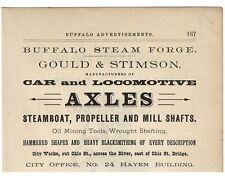
1886 BUFFALO BLACKSMITH STEAM FORGE STEAMBOAT LOCOMOTIVE MINING TOOLS WROUGHT $52.50
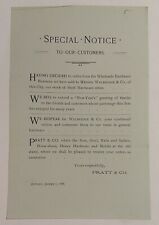
1886 BUFFALO, NY. "PRATT & CO" Hardware Store Notice Letter Antique Advertising $65.49
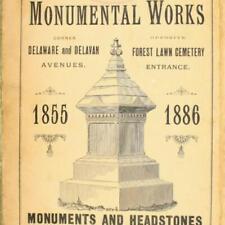
1886 BUFFALO FOREST LAWN CEMETERY MONUMENT CRAWFORD MONUMENTAL WORKS GRAVE STONE $78.90
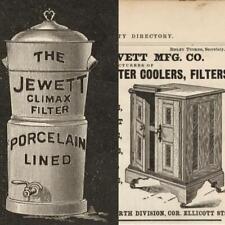
1886 BUFFALO JEWETT REFRIGERATORS WATER COOLERS JOHN C VICTORIAN ERA BIRD CAGES $21.30
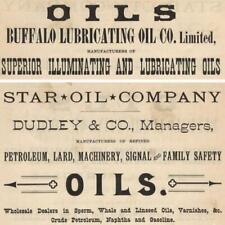
1886 BUFFALO SPERM WHALE OIL STAR OIL LUBRICATING VICTORIAN ERA GASOLINE LARD $31.50
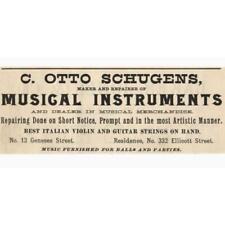
1886 BUFFALO MUSICAL INSTRUMENT MAKER OTTO SCHUGEN VICTORIAN ERA ITALIAN VIOLINS $12.25
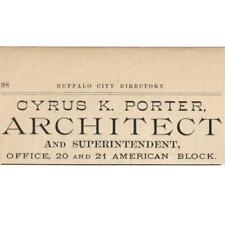
1886 BUFFALO NY ARCHITECT CYRUS K PORTER VICTORIAN ERA COAL IRON TRINITY CHURCH $52.50
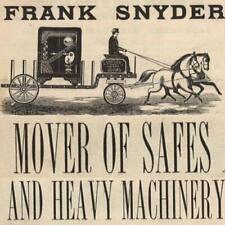
1886 BUFFALO SNYDER FRANK MOVER SAFES MACHINERY HORSE CARRIAGE WEST EAGLE ST $52.50
|